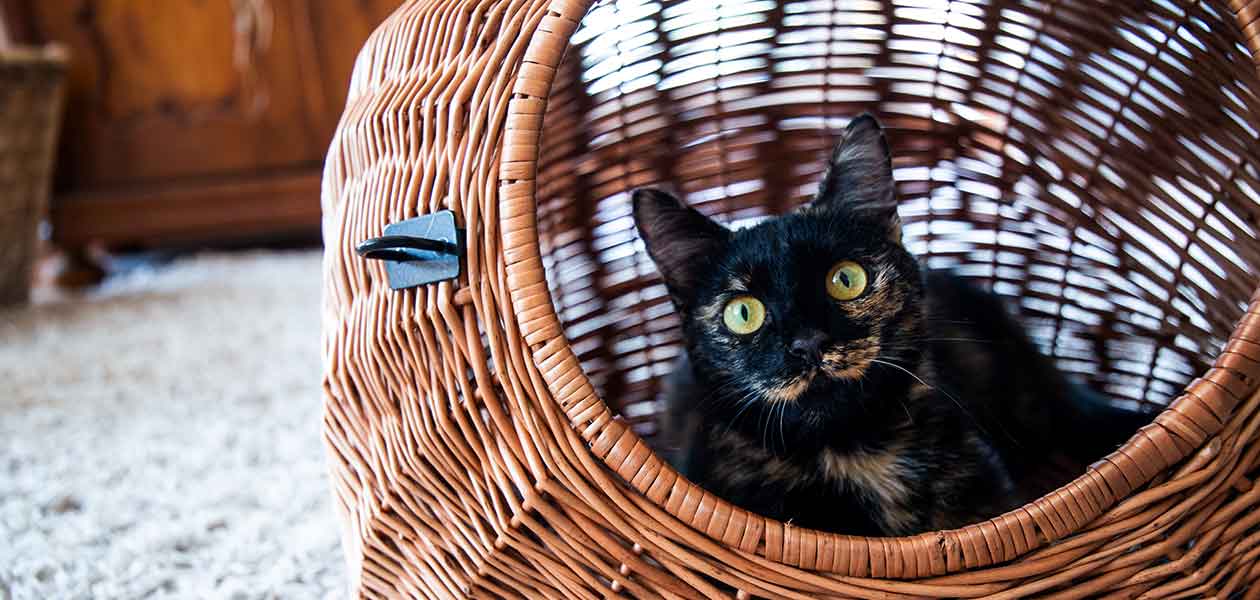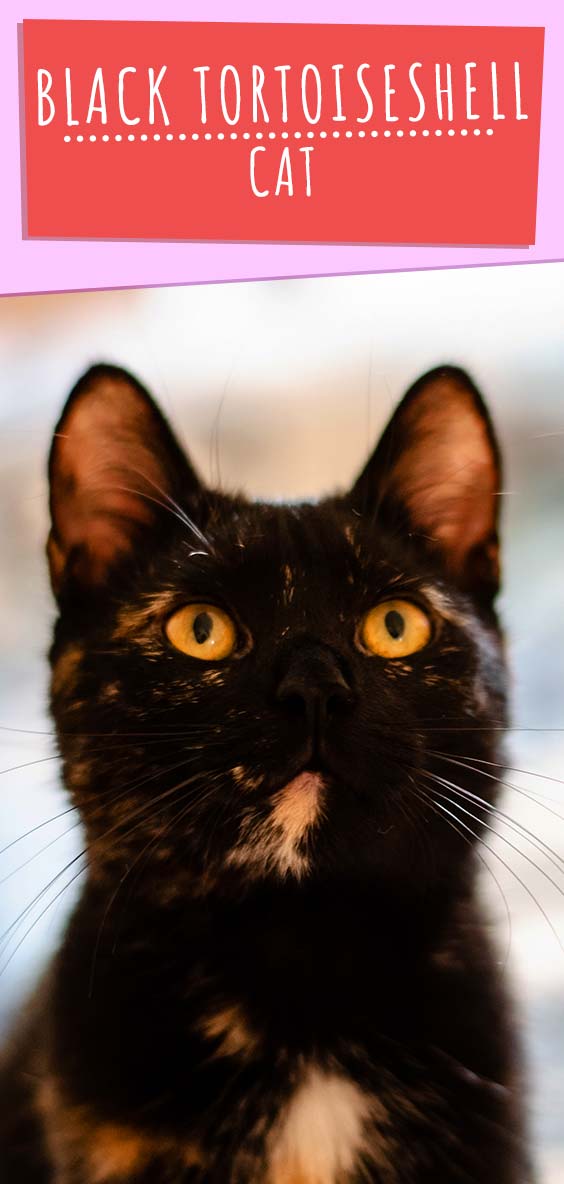
A black tortoiseshell cat has patches of black and orange fur in their coat. But, they are not a specific breed – many cat breeds can have this tortoiseshell coloring.
The black patches are caused by densely concentrated eumelanin pigment in the strands of hair.
Black tortie cats are almost always female, and their temperament varies widely depending on their breed. Let’s find out more.
What is a Black Tortoiseshell Cat?
A black tortoiseshell cat, also known as a black tortie cat, or black and orange tortoiseshell cat, has a mixture of black and orange hairs in their coats.
It is the most common and instantly recognizable colorway for the tortoiseshell pattern.
But it’s not the only tortie color combination. Besides black torties, you can also get more unusual combinations including chocolate and orange, blue and cream, and lilac and caramel.
A black tortoiseshell cat isn’t a single breed in it’s own right either.
There are several popular and also less-well-known cat breeds which can have this pretty pattern.
So black tortie cat personality, life expectancy, and care needs are related to more than just the color of their coat.
But let’s dwell on those special looks just a bit longer before we dive into those topics!
The Black And Orange Tortoiseshell Cat Pattern
Classic tortoiseshell cats have a randomly arranged pattern of black and orange patches in their fur.
The patches can be small, so that they resemble speckling or brindle patterns.
Or, they can be large and distinct. This is closely associated with an increase in the amount of white in their coat too – eventually leading to cats which are calico, rather than tortoiseshell.
Amount of Each Color
The ratio of black and orange patches in a tortie cat’s coat is completely random. So, statistically it’s most likely to end up even, or close to even.
But some tortie cats have perceptibly more of one color than the other.
Cat owners and breeders may use the phrase “black tortoiseshell cat” to describe a girl who’s black patches greatly outnumber her orange patches.
Like this one:

Next let’s take a moment to admire how this striking pattern happens, and why it’s always restricted to female cats!
Black Tortoiseshell Cat Genetics
All of the possible colors and patterns in cats’ coats are created by just two pigments: eumelanin, which is black, and pheomelanin, which is red.
The genes responsible for producing each of these pigments both occupy the same place on the X sex chromosome.
That means boy cats, who only have one X chromosome can only make either black or red pigment, depending which gene they inherit.
But girl cats have two X chromosomes. So, they can inherit the gene which codes for eumelanin production on one, and the gene which codes for pheomelanin on the other.
And here’s where the magic happens…
Female cats don’t need both copies of the X chromosome dishing out instructions in every cell of their body.
That would cause an unnecessary, and sometimes contradictory, duplication of information.
So, whilst female kitten embryos are still developing in the womb, one X chromosome in every cell is switched off at random.
This process is called X chromosome inactivation.
It means that the pigment producing cells under a female cat’s skin have a random distribution of instructions for black or red pigment. Which creates the tortoiseshell pattern.
Because X chromosome inactivation is completely random, a breeder can’t plan for a litter of kittens which is more black tortoiseshell than balanced or orange. Even if their parents had mostly black patches.
Black Tortoiseshell Cat Temperament
Black tortie cats are all bewitching on the outside. But what about their personalities?
Is there a typical black tortoiseshell cat temperament which makes them so desirable?
In short, no!
Since the black and orange tortoiseshell pattern isn’t a breed, or exclusive to any particular breed, there’s lots of diversity in the types of cat which can have it.
Some Black Tortoiseshell Cat Breed Examples
Black tortie cats can be
- British Shorthair
- American Shorthair
- Persian
- Maine Coon
- Cornish Rex
And Manx breed, among others.
They can also be a hybrid of two or more known breeds, or “domestic”, meaning of unknown ancestry.
Breeds like the Maine Coon are known for being sociable, energetic and expert hunters.
Whilst Persian cats are typically more chilled out.
Looking for a link between coat color and temperament
At the time of writing, there’s no evidence that coat color in cats is biologically linked to temperament.
But, there is evidence that people perceive cats with specific colors and patterns as having trademark attributes.
And when it comes to black cats, and cats that are primarily black, these felines also have to compete against superstition and modern trends as well.
For hundreds of years, people have regarded cats as bad luck, and portents of death or misfortune.
More recently, some rescue shelters have reported that people are less keen to adopt black cats because they don’t photograph well for social media.
In fact, black, and primarily black cats like black torties take the longest to be adopted from rescue shelters.
Black Tortoiseshell Cat Health
Whilst some colors, such as white coats, are closely linked to an increased risk of specific health problems, this isn’t the case for tortoiseshell coats.
So, just like temperament, a black tortie’s health is going to be influenced by their breed more than their coat color.
Cornish Rex torties will be more prone to sunburn due to having such short coats.
And Maine Coon torties will be more at risk of hip dysplasia, due to their size, and hereditary prevalence of this condition in the breed.
Plus, by virtue of being female, black tortie cats will inevitably be more prone to some of the health problems which specifically affect female cats, such as mammary cancer.
Some of these conditions, such as hip dysplasia, can be protected against by screening breeding cats ahead of mating.
Black Tortoiseshell Cat Grooming
Cats are famously fastidious.
They largely take care of their own grooming, unless something is stopping them, such as getting old, being overweight, or have an overwhelmingly long coat.
All black and orange torties benefit from a quick once over with a slicker brush once a week to remove tangles and debris.
It’s a great way to keep tabs on their overall condition too!
Longhaired torties, such as black tortie Persians and Maine Coons may need help with grooming more often.
Your Black Tortoiseshell Cat
Black and orange tortoiseshell cats are among the most popular cat patterns.
The proportion of black vs orange fur in their coat is completely random. So, it’s impossible to engineer an especially black tortie cat.
But you’ll find they do crop up in all breeds. Their health and temperament will be determined more by their breed than their coat pattern.
Do you have a black tortie cat?
We’d love to hear about them in the comments box down below!
Readers Also Liked
- Tortoiseshell Calico Cat – Which Kitties Meet This Description?
- Blue Tortoiseshell Cat – A Guide To The Rare Blue Tortie
- What Breed Is My Cat? A Guide To Identifying Your Cat’s Breed
- Dilute Tortie – Unravelling a Magical Coat Color
References and Resources
- Delgado. Human Perceptions of Coat Color as an Indicator of Domestic Cat Personality. Anthrozoos. 2015.
- Kogan et al. Cats in Animal Shelters: Exploring the Common Perception that Black Cats Take Longer to Adopt. The Open Veterinary Science Journal. 2013.
- Ahn & Lee. X chromosome: X inactivation. Nature Education. 2008. .
Leave a Reply